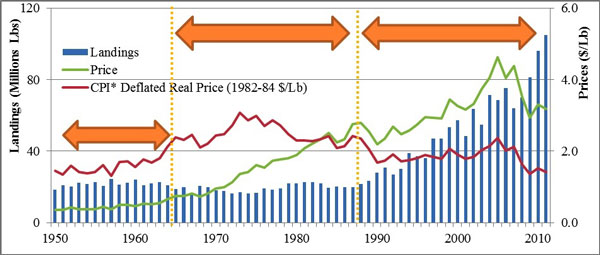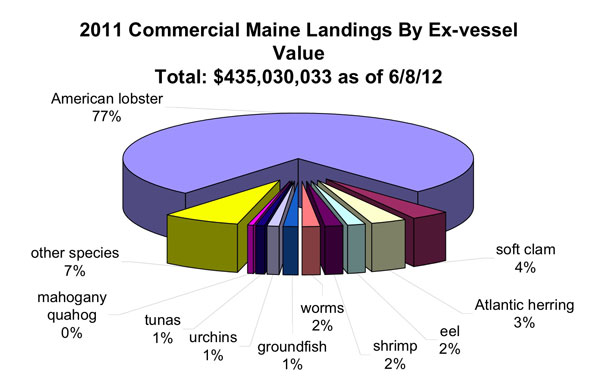Lobster Fishery: Who Gets In?
by Laurie Schreiber

This graph shows that Maine lobster landings increased dramatically in the last two decades, but the ex-vessel price in 2011 was as low as it was in 1960.
PORTLAND – A report released in early December is expected to provide guidance to the Department of Marine Resources (DMR) as it considers new access strategies for the lobster fishery.
Initiated by the 125th Legislature and commissioned by the DMR, the Gulf of Maine Research Institute (GMRI) produced “An Independent Evaluation of the Maine Limited Entry System for Lobster and Crab.”
The DMR plans to hold meetings in communities in the coming months to get industry input on potential changes to the limited entry system. In 2011, Rep. Dianne Tilton (District 33), a sponsor of the bill that authorized the study, said the bill arose in response to questions posed to the Legislature’s Regulatory Fairness and Reform Committee.
“We held several hearings to hear about regulations that were impeding economic growth,” she said at the time. “We heard about regulations that comprise Maine’s limited entry system for lobster fishing. Our committee understood this subject was outside the committee’s expertise and wasn’t something that should be changed lightly. The system is very controversial; it’s riddled with unintended consequences and a sense of unfairness. We are the fairness and reform committee and that’s the message we heard from folks, that limited entry is unfair.”
The Maine lobster fishery was an open access fishery until the mid-1990s. The limited entry system has been in place for 15 years, as a way to reduce the number of licenses and achieve a 30 percent reduction in the number of trap tags, due to concern that fishing effort was too high. As the program matured, the goal of the program was changed to achieve a reduction in trap tags, rather than licenses, since tags represent the actual effort in the water.
But since 1997, although the number of all license types declined statewide by 12 percent, the number of tags increased by 13 percent, going from 2.1 million to 3.1 million in 15 years, mostly in the eastern half of Maine. It became apparent that controlling numbers of licenses or trap tags didn’t directly impact the conservation of the lobster resource. Instead, the system became a socio-economic tool that controlled who had access to the lobster resource.
The system has provided opportunities for children through its student license program. But for others, including those who have learned the trade through the state’s apprentice program, the system has resulted in long waiting lists for licenses.
The DMR awarded a contract to GMRI in July 2012. GMRI surveyed and held meetings with lobstermen and individuals from the waiting lists and the apprentice program, students, and others with connections to the fishery. According to the report, “Maine’s lobster fishery has seen two decades of dramatically increasing landings from 57 million pounds in 2000 to 105 million pounds in 2011.”
The stock is deemed healthy and fishing is occurring at a sustainable level. “But there is uncertainty about the future robustness of the stock,” the report says. A new stock assessment is scheduled for 2013.
In 2011, there were 4,933 commercial license holders, who bought a total of 2,876,388 tags. In addition, there were 761 student license holders with 49,238 tags and 269 apprentice license holders, who cannot buy tags. Not all license holders actively fish; 1,107 commercial licenses did not record any landings in 2011, 22 percent of the total.
“The overall effect of the exit-to-entry ratios established in most zones has been a decrease in the number of licenses,” the report says. “Since the current limited license system does not control effort (as witnessed by the steady increase in traps), it is not the basis for a conservation strategy for Maine’s lobster fishery – other conservation measures and ecological conditions are responsible for the past two decades of growing harvests,” the report says. “Thus, any changes to the limited entry system would address only social and economic issues related to who gets the privilege to fish. Making such decisions therefore entails making trade-offs between the profitability of existing fishermen and potential profitability of new entrants.”
GMRI identified four key deficiencies in the system: latent effort, long waiting periods, under accounting of retiring tags, and an inadequacy of the system to respond to a resource decline.
Latent effort represents a risk to the fishery because this high level of potential new effort would dramatically increase the pressure on the lobster resource.
“Latent effort refers to unused potential effort in a fishery,” the report says. “It takes three primary forms in Maine’s lobster fishery: commercial licenses that have been issued but are not being used; trap tags that have been issued but not being fished; and the potential traps associated with licenses holders who do not currently buy their maximum allowable number of tags.
GMRI estimates that 391,142 trap tags which have already been issued could be actively fished right away, and another 845,444 new traps could be issued immediately to eligible fishermen.
“This indicates that a combined total of 1,236,586 additional traps could enter the state’s waters, if all license holders purchased tags for, and fished, their maximum number of traps. That represents a potential 39 percent increase in existing effort,” the report says.
Long waiting periods refers to the length of time people spend on the waiting list to get a commercial license. With an average of 60 new licenses being issued every year, “it could take 20 years or more for all 296 current waiting list members to get a commercial license (although those at the top of the list would get theirs much sooner, and 41 of these individuals are zone transfers).”
With trap-based exit-to-entry ratios creating lengthy waiting periods, “it is critical to account fully for traps associated with a license when it is retired or not renewed,” the report says. “Since many fishermen scale down their operations in the several years preceeding their retirement, the number of tags associated with the license when they retire is often less than the number they fished historically.”
Also, the system is inadequate to respond to a biological emergency, the report says.
“Despite a decline in the number of licenses overall (as envisioned when exit-to-entry ratios were introduced), the number of traps issued has climbed. In addition, fishing capacity has increased, through larger vessels and more vessels with additional crew, so more pounds are harvested from those traps. Thus, the current system does not control effort effectively.”
Source: Maine DMR
Other deficiencies ID’d
Through its outreach efforts, GMRI identified other deficiencies. These included the complaint, among those waiting to gain entry into the fishery, about the provision that allows student license holders to enter the fishery without joining the waiting list if they complete their apprenticeship before they turn 18.
However, GMRI says, “This provision does allow qualified students to enter the fishery, but it does not lengthen the waiting period for others, since students are not subject to the exit-to-entry ratios. Between 2001 and 2011, a total of 847 new licenses have been issued. Of those, roughly half were issued to students. There is strong support for the student license program and the role it plays in communities. But the question remains: should students be allowed to enter without a waiting period?”
There is also a strong perception that current fishermen are keeping new entrants out of the fishery while they make more and more money, the reports says. To address the latent effort problem, GMRI recommended instituting a tiered licensing system.
“While it is critical to address the latent effort in the system, it is equally important to do so in a manner that does not undermine the expectations of those who hold unused licenses and trap tags or may be planning to build their business over time,” the report says.
“Essentially, a tiered license system would create four levels of commercial licenses, with increasing amounts of allowed traps. Existing license holders would be divided into the four tiers based on landings and tag history, reflecting their current and recent activity.
Access to lower tiers would be open to all who have completed the apprentice program. But access to upper tiers would be limited by the exit-to-entry ratios, which could be set to one-to-one,” the report proposes.
The problem of long waiting periods could be addressed through a change in trap licensing, the report says. “Waiting periods are inevitable in any limited-entry system, but are causing tension and hindering the ability for families to pass down their businesses. One way to reduce waiting periods would be to change the way the number of retired traps are calculated. If the maximum number of tags a license had were retired rather than the license’s number in its final year, on average 27 percent more traps would be counted as retiring, reducing waiting periods,” the report says.
The full report can be downloaded from maine.gov/dmr/GMRIReportRelease.

